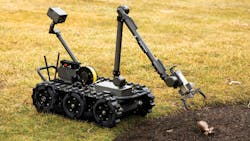In this week’s roundup from the Association for Unmanned Vehicle Systems International, which highlights some of the latest news and headlines in unmanned vehicles and robotics, the U.S. Air Force orders robotic hazard disposal units, city employees in Fremont, CA, USA prepare for autonomous shuttle service, and the U.S. Coast Guard demonstrates the potential of a new autonomous submarine.
Compiled by Brian Sprowl, Associate Editor, AUVSI
U.S. Air Force orders 180-plus FLIR Systems Centaur UGVs
Through a $23 million contract sourced through the Dept. of Defense Man Transportable Robotic System Increment II (MTRS Inc II) program, the United States Air Force has ordered more than 180 of FLIR Systems’ Centaur UGVs, plus spares.
A remotely operated, medium-sized UGV system, Centaur provides a standoff capability to detect, confirm, identify, and dispose of hazards. The open-architected robot, which weighs approximately 160 pounds, is equipped with an advanced EO/IR camera suite, a manipulator arm that reaches more than six feet, and the ability to climb stairs. The robot's modular payloads can be used for CBRNE detection and other missions.
Shipments of the UGVs are expected to begin in the second quarter of 2020.
“Centaur gives operators a highly versatile, man-transportable UGV that helps saves lives by keeping humans away from danger,” says David Ray, president of the Government and Defense Business Unit at FLIR.
“We’re pleased the Air Force has chosen Centaur as its mid-sized robot solution and that the MTRS Inc II program can serve as an efficient procurement vehicle.”
In 2017, FLIR Systems’ legacy business, Endeavor Robotics, was chosen as the medium-sized robot provider for MTRS Inc II by the U.S. Army. Endeavor developed a newly designed UGV, Centaur, as its MTRS Inc II platform.
Under that multi-year program of record, which upon award was valued at up to $158 million, including options, FLIR has begun delivering Centaur units to the Army.
The FLIR Centaur will be used by Air Force Explosive Ordnance Disposal (EOD) teams to help disarm improvised explosive devices (IEDs), unexploded ordnance, and similar hazardous tasks. A variety of sensors and payloads can be added to Centaur to support other missions.
City of Fremont, California, Pony.ai launch autonomous vehicle pilot program for city employees
On Monday, Feb. 24, the City of Fremont, California and Pony.ai launched a pilot program that uses Pony.ai’s shared, on-demand, autonomous last-mile service to provide rides for a group of City employees.
Participating employees will be transported from Fremont’s Amtrak/ACE Station to City Hall and City of Fremont Development Services Center via Pony.ai’s autonomous vehicles, which have a safety operator present in each vehicle to ensure safe and smooth navigation of complex road scenarios.
Each vehicle is equipped with Pony.ai’s full-stack autonomous driving technology, which serves as the “brains” of the vehicle. The technology is also expected to serve as a building block to the future Smart City, the entities say.
“By partnering with a local autonomous technology firm Pony.ai, the City of Fremont is acting as a test bed for a transportation solution that has the potential to alleviate congestion, reduce carbon emissions, decrease the number of traffic accidents, and optimize vehicle and land usage,” says Fremont Mayor Lily Mei.
“Together, we are laying the groundwork for a safer and smarter city.”
The Fremont Mobility Action Plan was adopted in March 2019 to address some of the issues that Mayor Lily Mei spoke of. The Pony.ai pilot program is one solution that the city of Fremont is looking into to help meet various goals and serve the internal travel demands of Fremont’s growing population of 230,000 residents.
“In the long term, Pony.ai aims to offer a service that not only addresses the community’s daily transit needs, but also serves as a key enabler to a broader smart city infrastructure in Fremont and beyond,” says Pony.ai CEO James Peng.
“With our autonomous driving technology, we will facilitate business activity and create economic value for the broader region, as well as contribute to a safe and congestion-free transportation environment.”
Throughout the pilot program, the pilot program team made up of representatives from the city of Fremont and Pony.ai will monitor performance, user feedback, and unknowns to evaluate results and explore options for program expansion.
Spatial Integrated Systems to demonstrate autonomous USV to examine feasibility of improving Maritime Domain Awareness
After being awarded a contract with the US Coast Guard (USCG), Spatial Integrated Systems Inc. (SIS) will demonstrate an autonomous USV to examine the feasibility of improving Maritime Domain Awareness (MDA) in the remote Pacific Ocean.
Based in Virginia Beach, Virginia, SIS has partnered with MetalCraft Marine U.S. and Honolulu, Hawaii’s Navatek, resulting in the combination of the SIS Multi-Agent Robotic Teams (SMART) Autonomy System and the MetalCraft 7m Interceptor Boat for commercial sale as an “intelligent, goal-oriented” autonomous USV.
SIS describes the integration of its SMART Autonomy into MetalCraft’s 7m Interceptor as “seamless” and “inexpensive,” adding that it will demonstrate to the USCG the opportunity to optionally unman/man any auxiliary craft in their inventory.
COLREGS compliant, SMART Autonomy is a leader in multi-robot control, SIS says, as it offers “unmatched capability for swarm and cooperative missions with multiple UxVs.” Currently being used by the USCG Cutter Boat-Large (CB-L) Program, the 7m Interceptor was chosen for several reasons, including its ability to operate in extreme conditions, its proven ability to be launched and recovered from USCG Cutters, and its large space for future payloads.
“We are excited to demonstrate the maturity of our technology and the flexibility to employ multiple optionally manned platforms affording a Coast Guard Commander tremendous opportunities,” says Sam Lewis, SIS’s president & chief operating officer.
SIS says that it will demonstrate a comprehensive ability to detect threats and safeguard U.S. homeland, prevent illegal fishing, and stop intrusion into protected marine sanctuaries. The open ocean demonstration will take place this summer approximately 30 miles south of Oahu, Hawaii in a 20 square mile area.
“Spatial Integrated Systems is proud to have been chosen by the USCG to conduct this demonstration and to play a leading role in the sustainment of America’s edge in autonomy and unmanned systems,” the company says.
Share your vision-related news by contacting Dennis Scimeca, Associate Editor, Vision Systems Design
SUBSCRIBE TO OUR NEWSLETTERS

